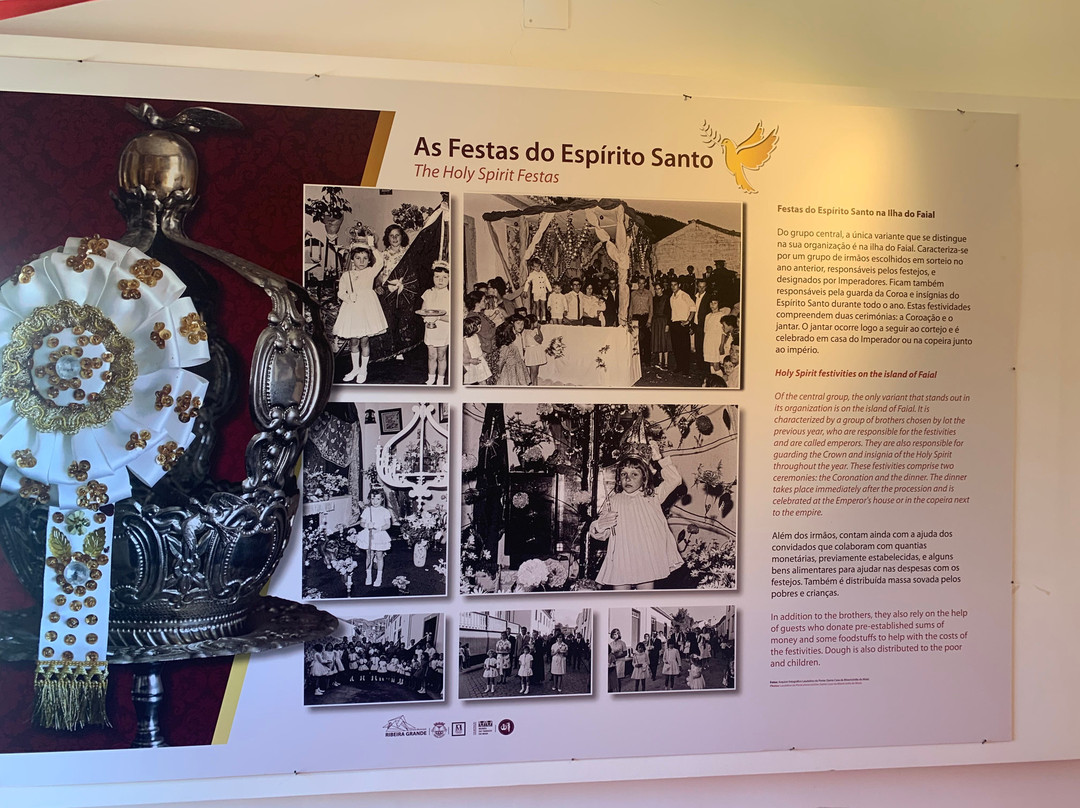的点评
Great place to learn about how emigration has affected the Azores
Museu da Emigração Açoriana的点评
点评:My sister and I visited the Museu de Emigracao in Ribeira Grande in June 2024 as part of a family vacation and a trip to see where our grandparents and great-grandparents were born. I’d highly recommend the museum to anyone visiting the Azores to learn about family history, and would recommend the museum to anyone curious about history.
The museum’s relatively small - one large room in the former town fish market - but covers a remarkably wide range of topics: reasons for emigration, stories about emigration to Brazil, Canada, and the US; and traditions brought by immigrants (Holy Ghost festivals). The displays and content are also first-rate, with good pictures and artifacts, and very good English and Portuguese content on display boards.
I was most impressed at how much I learned in spite of already knowing a fair amount about emigration from the US west coast viewpoint. When we arrived, the docents highlighted that the museum was not just about the emigrants, but also about the feeling of loss for those left on the islands as their children emigrated to the US or EU, or as entire families moved abroad. The section on “Barrels from America” highlighted how Azoreans similarly tried to help out the friends and family back in the Azores. I’d heard about similar traditions in the US from Filipino immigrants (“balikbayan boxes”) and heard stories from coworkers about shipping similar packages to family back in India. A tour guide from Pico later told me that he’d remembered such gifts from US cousins when he was a kid in the 1990s, reminding me how recent the tradition was. The sections on Canadian, US East Coast, and Brazilian immigration helped me understand the differences in the immigrant experiences for these groups versus Portuguese emigrants in California. The section on the Holy Ghost festivals highlighted how the traditions varied by island, and how different emigrant groups brought the traditions of different islands to the US west coast vs US east coast. The museum as a whole gave me a much better understanding of the larger emigration story that helped us as we travelled between the islands and heard stories about the family that stayed behind and about the Azores as it is now.
The docents were also kind enough to open a separate building with displays of Holy Ghost festival regalia and displays.
I wouldn’t have minded more content, but all the current displays certainly taught me lots I didn’t know already.
I was really happy we’d stopped, and disappointed I didn’t get to bring the rest of our families to see the museum. It’s also a pleasant stop - the restaurants in the old produce market next door were a great place to get lunch, and the Continente supermarket one block down was a wonderfully stocked market.
The museum’s relatively small - one large room in the former town fish market - but covers a remarkably wide range of topics: reasons for emigration, stories about emigration to Brazil, Canada, and the US; and traditions brought by immigrants (Holy Ghost festivals). The displays and content are also first-rate, with good pictures and artifacts, and very good English and Portuguese content on display boards.
I was most impressed at how much I learned in spite of already knowing a fair amount about emigration from the US west coast viewpoint. When we arrived, the docents highlighted that the museum was not just about the emigrants, but also about the feeling of loss for those left on the islands as their children emigrated to the US or EU, or as entire families moved abroad. The section on “Barrels from America” highlighted how Azoreans similarly tried to help out the friends and family back in the Azores. I’d heard about similar traditions in the US from Filipino immigrants (“balikbayan boxes”) and heard stories from coworkers about shipping similar packages to family back in India. A tour guide from Pico later told me that he’d remembered such gifts from US cousins when he was a kid in the 1990s, reminding me how recent the tradition was. The sections on Canadian, US East Coast, and Brazilian immigration helped me understand the differences in the immigrant experiences for these groups versus Portuguese emigrants in California. The section on the Holy Ghost festivals highlighted how the traditions varied by island, and how different emigrant groups brought the traditions of different islands to the US west coast vs US east coast. The museum as a whole gave me a much better understanding of the larger emigration story that helped us as we travelled between the islands and heard stories about the family that stayed behind and about the Azores as it is now.
The docents were also kind enough to open a separate building with displays of Holy Ghost festival regalia and displays.
I wouldn’t have minded more content, but all the current displays certainly taught me lots I didn’t know already.
I was really happy we’d stopped, and disappointed I didn’t get to bring the rest of our families to see the museum. It’s also a pleasant stop - the restaurants in the old produce market next door were a great place to get lunch, and the Continente supermarket one block down was a wonderfully stocked market.
翻译:2024 年 6 月,我和姐姐参观了里贝拉格兰德的移民博物馆,这是一次家庭度假和参观祖父母和曾祖父母出生地的旅行的一部分。我强烈推荐任何前往亚速尔群岛了解家族历史的人参观这个博物馆,并向任何对历史感兴趣的人推荐这个博物馆。
博物馆相对较小——前城镇鱼市的一个大房间——但涵盖的主题非常广泛:移民的原因、移民到巴西、加拿大和美国的故事;以及移民带来的传统(圣灵节)。展览和内容也是一流的,有很好的图片和文物,展板上有非常好的英语和葡萄牙语内容。
尽管我已经从美国西海岸的角度对移民有了相当多的了解,但我对自己学到的东西印象最深刻。当我们到达时,讲解员强调,博物馆不仅关乎移民,还关乎那些留在岛上的人们,因为他们的孩子移民到美国或欧盟,或者整个家庭都移居国外,而他们的失落感。“来自美国的桶”部分强调了亚速尔人如何同样地试图帮助亚速尔群岛的朋友和家人。我从菲律宾移民(“balikbayan 盒子”)那里听说过美国也有类似的传统,也听过同事们讲述将类似包裹寄给印度家人的故事。一位来自皮科的导游后来告诉我,他记得 1990 年代他还是个孩子的时候,美国表亲送过这样的礼物,这让我想起了这个传统是多么新近。关于加拿大、美国东海岸和巴西移民的部分帮助我了解了这些群体与加利福尼亚葡萄牙移民的移民经历的差异。关于圣灵节的部分强调了不同岛屿的传统如何不同,以及不同的移民群体如何将不同岛屿的传统带到美国西海岸和美国东海岸。整个博物馆让我更好地了解了更大的移民故事,这对我们在岛屿之间旅行、听到留守家庭的故事和亚速尔群岛现在的情况很有帮助。
讲解员也很好心地打开了一栋单独的建筑,展示圣灵节的服饰和展品。
我并不介意更多的内容,但所有当前的展览确实教会了我很多我以前不知道的东西。
我很高兴我们停下来了,很遗憾我没有带我们其他的家人来参观博物馆。这也是一个令人愉快的停留——隔壁旧农产品市场的餐馆是吃午餐的好地方,而一个街区外的 Continente 超市是一个库存丰富的市场。
博物馆相对较小——前城镇鱼市的一个大房间——但涵盖的主题非常广泛:移民的原因、移民到巴西、加拿大和美国的故事;以及移民带来的传统(圣灵节)。展览和内容也是一流的,有很好的图片和文物,展板上有非常好的英语和葡萄牙语内容。
尽管我已经从美国西海岸的角度对移民有了相当多的了解,但我对自己学到的东西印象最深刻。当我们到达时,讲解员强调,博物馆不仅关乎移民,还关乎那些留在岛上的人们,因为他们的孩子移民到美国或欧盟,或者整个家庭都移居国外,而他们的失落感。“来自美国的桶”部分强调了亚速尔人如何同样地试图帮助亚速尔群岛的朋友和家人。我从菲律宾移民(“balikbayan 盒子”)那里听说过美国也有类似的传统,也听过同事们讲述将类似包裹寄给印度家人的故事。一位来自皮科的导游后来告诉我,他记得 1990 年代他还是个孩子的时候,美国表亲送过这样的礼物,这让我想起了这个传统是多么新近。关于加拿大、美国东海岸和巴西移民的部分帮助我了解了这些群体与加利福尼亚葡萄牙移民的移民经历的差异。关于圣灵节的部分强调了不同岛屿的传统如何不同,以及不同的移民群体如何将不同岛屿的传统带到美国西海岸和美国东海岸。整个博物馆让我更好地了解了更大的移民故事,这对我们在岛屿之间旅行、听到留守家庭的故事和亚速尔群岛现在的情况很有帮助。
讲解员也很好心地打开了一栋单独的建筑,展示圣灵节的服饰和展品。
我并不介意更多的内容,但所有当前的展览确实教会了我很多我以前不知道的东西。
我很高兴我们停下来了,很遗憾我没有带我们其他的家人来参观博物馆。这也是一个令人愉快的停留——隔壁旧农产品市场的餐馆是吃午餐的好地方,而一个街区外的 Continente 超市是一个库存丰富的市场。

此点评仅代表旅行者个人的主观意见,并不代表TripAdvisor以及其合作方的意见。
关于我们
|
新闻动态
|
商务合作
|
会员中心
|
业主中心
|
业主通
|
常见问题
|
意见反馈
|
联系我们
|
营业执照
© 2025 Tripadvisor 版权所有。
使用条款 |隐私政策 |网站工作原理
部分照片由 VFM Leonardo 提供。
* Tripadvisor不是旅行社,也不是旅游预订服务代理商。我们提供免费、客观、公正的旅游资讯服务。 (显示更多)
TripAdvisor LLC 既不是预订代理商,也不是旅游运营商,不会向网站用户收取任何服务费。 按照规定,在 Tripadvisor 发布机票价格、游览和旅行套餐的合作伙伴(航空公司、旅行提供商及预订代理商),其标价须包含所有费用和附加费用。 例如, 机场出入境税费、消费税与其他服务费、手续费、杂费及附加费用。 当您向我们的某个合作伙伴进行预订时,请务必查阅他们的网站以了解当地行政部门要求的所有适用费用的具体情况。 除非另有说明,机票价格通常指的是一个人的价格(以人民币计)。
为方便起见,TripAdvisor LLC 根据从我们的预订合作伙伴获取的空房率计算每个酒店的均价。 对于游览和景点来说,所显示价格通常是每位成人的最低可用价格。 对于列出的任何旅行套餐或优惠,TripAdvisor LLC 无法保证任何特定的费率或价格。 此外,酒店均价每晚会更新,并以您的首选币种表示(使用现行汇率)。 由于这些已换算的价格是预估价格,因此,有关具体金额和币种请与预订网站进行核实。
此外,TripAdvisor LLC 无法保证我们网站上宣传的价格随时有效。 标价可能需要预订一定天数才能生效,或有不可用日期、使用条件或限制。
TripAdvisor公司对外部网站的内容一概不负责。优惠价格中不含税和其他费用。
ICP证:沪B2-20200433
沪ICP备20013175号
 沪公网安备31010502005427号
沪公网安备31010502005427号鹰程信息技术(上海)有限公司
货币/国家及地区
¥CNY
中国

